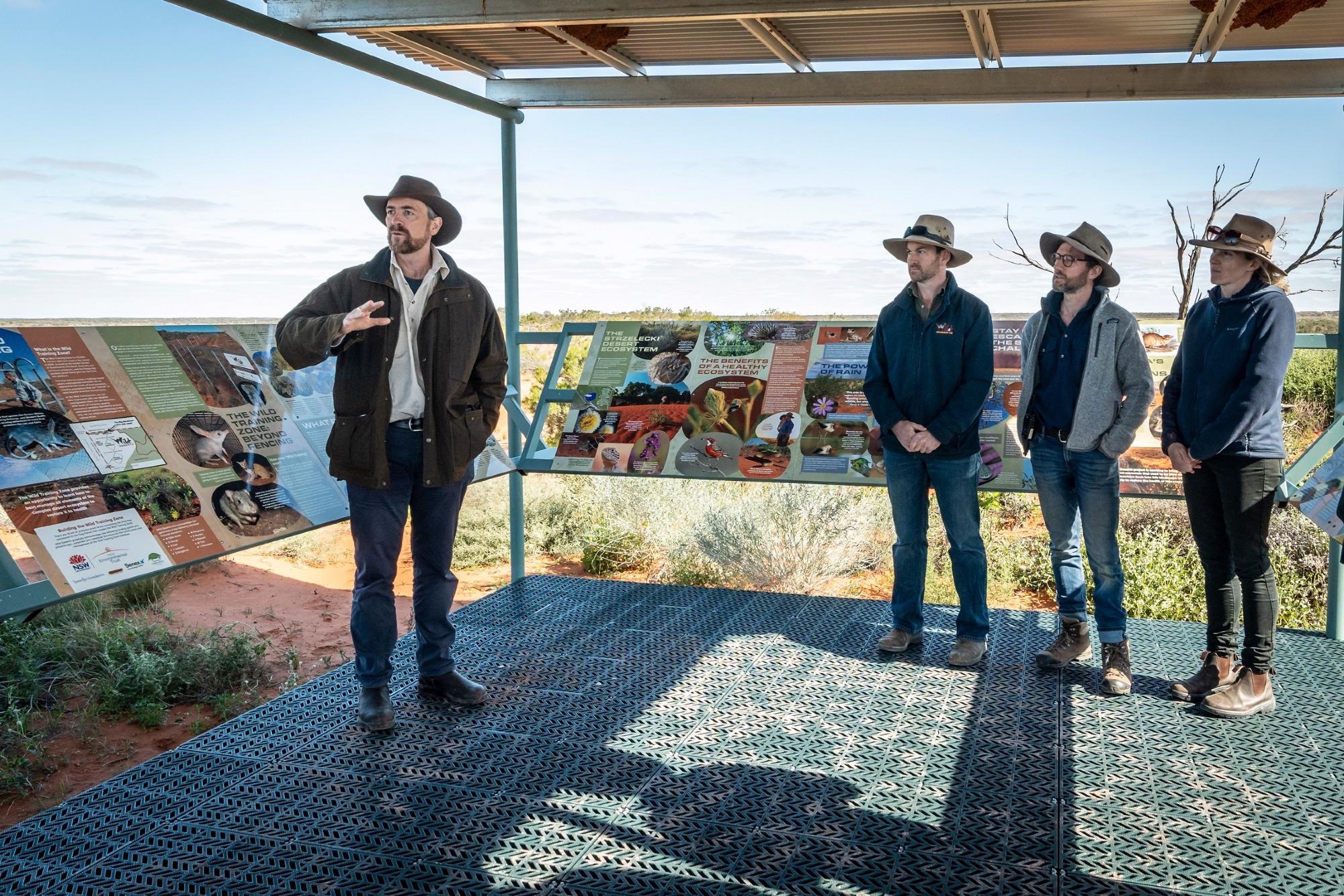UNSW Sydney Vice-Chancellor and President Professor Attila Brungs opened the Talpero Lookout interpretation area in Sturt National Park, near Tibooburra in far western NSW on Saturday.
 UNSW Sydney Vice-Chancellor and President Professor Attila Brungs (far left) opened the Talpero Lookout interpretation area on Saturday. Image Credit: Doug Gimesy
UNSW Sydney Vice-Chancellor and President Professor Attila Brungs (far left) opened the Talpero Lookout interpretation area on Saturday. Image Credit: Doug Gimesy
The jointly funded initiative features the work underway through the Wild Deserts consortium between UNSW and Ecological Horizons in collaboration with the NSW National Parks and Wildlife Service. The project, funded by the NSW Government, is working to reintroduce locally extinct mammals and restore the desert ecosystem in Sturt National Park.
Prof. Brungs said it was a great pleasure to officially open this site to the public.
“UNSW Sydney’s research and expertise is underpinning this important NSW Government initiative, through its involvement in the Wild Deserts consortium, informing conservation management and restoration of Australia’s ecosystems, as well as providing a great opportunity to provide comprehensive information to the public,” he said.
The area is named after the western barred bandicoot’s aboriginal name, Talpero, once used throughout this area. The interpretation area consists of a parking area with display panels representing the desert ecology, depicting its plants, invertebrates, mammals, birds, frogs and reptiles. It also features the importance of Country for First Nations peoples and early European history including pastoralism in this National Park.
Dr Reece Pedler, UNSW Wild Deserts Project coordinator, said, “We have deliberately developed a comprehensive set of interpretation panels which highlight our scientific approach to the reintroduction of locally extinct mammals into Sturt National Park. In particular, we concentrate on the entire ecosystem not just on the mammals, and how these reintroductions affect the birds, the reptiles and even the soils.”
The Talpero Lookout interpretation area is home to a large sculpture (about 2m high x 3m wide) of a western barred bandicoot or Talpero. This species was once common before becoming extinct from the impacts of foxes and cats and other invasive species. The sculpture is made from discarded fencing wire used to create feral predator free areas, particularly from foxes and cats. Creation of the feral free areas allows locally extinct species, such as greater bilbies, to be reintroduced into Sturt National Park.
The 10-year project, from 2016-2026, will reintroduce seven locally extinct species that were an important part of this ecosystem more than a 100 years ago. Along with the bilbies, there are already four species now reintroduced into this area of Sturt National Park including the crest-tailed mulgaras, Shark Bay bandicoots and, most recently, the golden bandicoots.
Professor Richard Kingsford, Director of the Centre for Ecosystem Science and Wild Deserts Project Leader, was particularly excited about the initiative.
“What I really like about this interpretation area is that we are taking our science to the public. We want to explain how important it is to understand how these ecosystems work and maximise our opportunities to learn and inform similar initiatives as well as informing the public,” Prof. Kingsford said.
The interpretation area was funded by UNSW Sydney and the NSW Government through NPWS, under the project to reintroduce locally extinct mammals to Sturt National Park. The funding for three large sculptures – the bandicoot at the interpretation area, a bilby at Cameron Corner and a western quoll at the Fort Grey campground in Sturt National Park – was through the Sturt’s Steps project, funded by Infrastructure NSW through the Restart NSW program.
NSW Minister for the Environment James Griffin welcomed the establishment of this interpretation area.
“The NPWS team, in partnership with UNSW Wild Deserts, is making fantastic headway in Sturt National Park, reintroducing once locally extinct species such as golden bandicoots. This interpretation area is a great addition to Sturt National Park because it provides detailed explanations about why the reintroduction of mammal species is so important for biodiversity,” Mr Griffin said.